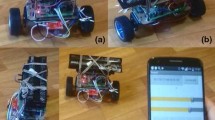Abstract
A two-wheeled self-balancing robot that works on the principle of inverted pendulum theory is most commonly used in control systems as an exemplar for comparing various control and optimization algorithms. This nonlinear dynamic system has gained much interest among researchers and engineers and the main aim is to stabilize this system with minimum deviation about any desired axis. As this system is affected by external disturbances and measured parametric errors, the need for the implementation of controllers has become crucial. Hardware and software implementation form the basis of the system design. The proposed work aims at the implementation of a PID controller for the successful working of the two-wheeled self-balancing robot driven by stepper motors. The closed-loop controller’s parameters have been optimized by using pole placement method. Besides, the response of the system under the fuzzy controller, created using Mamdani fuzzy interface engine in Simulink, has been illustrated.
Access this chapter
Tax calculation will be finalised at checkout
Purchases are for personal use only
Similar content being viewed by others
References
Ç. Abdullah, F. Botsali, Modeling and LQR control of a wheeled self-balancing robot, in International Mediterranean Science and Engineering Congress (IMSEC), pp. 4916–4920 (2016)
A. Singh, S. Chaurasia, A.K. Sanu, V. Agrawal, Automatic balancing robot. Int. J. Adv. Res. Innov. Ideas Educ. 3, 667–678 (2017)
S. Hellman, Two-Wheeled Self-Balancing Robot : Design and Control Based on the Concept of an İnverted Pendulum. Dissertation (2015)
K.P. Mohandas, Modern Control Engineering, Sanguine Technical Publishers, 2 (2016)
S. Kizir, Z. Bingul, C. Oysu, Fuzzy control of a real time inverted pendulum system, in Knowledge-Based Intelligent Information and Engineering Systems, Lecture Notes in Computer Science, 5177 (2008)
V. Mladenov, G. Tsenov, N. Harkiolakis, P. Karampelas, Neural Network Control of an inverted pendulum in an cart, in International Conference on Robotics, Control and Manufacturing Technology, pp. 112–120 (2009)
V.K. Pathak, S. Paliwal, Analysis and control of inverted pendulum system using PID controller. Int. J. Eng. Res. Appl. 7, 1–4 (2017)
Y.A. Almatheel, A. Abdelrahman, Speed control of DC motor using fuzzy logic controller, in International Conference on Communication, Control, Computing and Electronics Engineering (ICCCCEE), 1–8 (2017)
S.N. Sivanandam, S.N. Deepa, Principles of Soft Computing. Wiley (2007)
S. Salivahanan, R. Rengaraj, G.R.Venkatakrishnan, Control Systems Engineering. Pearson (2015)
G.R. Venkatakrishnan, R. Rengaraj, S. Salivahanan, Grey Wolf optimizer to real power dispatch with non-linear constraints, in CMES - Computer Modeling in Engineering and Sciences, vol. 115, issue 1, pp. 25–45 (2018)
G.R. Venkatakrishnan, R. Rengaraj, Grey Wolf optimization to hybrid renewable energy system located in Western Ghats Region—a case study. J. Electrical Eng. 18 (2018)
G.R. Venkatakrishnan, J. Mahadevan, R. Rengaraj, Optimal dispatch of residential distributed energy sources using self-adaptive differential evolution algorithm. Int. J. Appl. Eng. Res. 10(5), 12761–12778 (2015)
J. Mahadevan, G.R. Venkatakrishnan, R. Rengaraj, Differential evolution algorithm with parameter adaptation strategy for optimal design of hybrid renewable energy system. J. Electrical Eng. 16(3), 419–429 (2016)
G.R. Venkatakrishnan, R. Rengaraj, Overview of solar energy in India. Int. J. Dev. Res. 4(3), 605–608 (2014)
G.R. Venkatakrishnan, R. Rengaraj, Overview of wind energy in India. Int. J. Dev. Res. 4(3), 609–612 (2014)
G.R. Venkatakrishnan, R. Rengaraj, Differential evolution with parameter adaptation strategy for an optimal dispatch of residential distributed energy sources. J. Comput. Theor. Nanosci. 14(12), 5997–6002 (2017)
R. Jeya, G.R. Venkatakrishnan, R. Rengaraj, S. Anand, N. Bharath Raj, G. Ramanathan, Evolutionary optimization algorithms—a review. J. Adv. Res. Dyn. Control Syst. 1112–1122 (2018)
Author information
Authors and Affiliations
Corresponding author
Editor information
Editors and Affiliations
Rights and permissions
Copyright information
© 2021 The Author(s), under exclusive license to Springer Nature Singapore Pte Ltd.
About this paper
Cite this paper
Rengaraj, R., Venkatakrishnan, G.R., Moorthy, P., Pratyusha, R., Veena, K. (2021). Implementation of Controller for Self-balancing Robot. In: Suma, V., Chen, J.IZ., Baig, Z., Wang, H. (eds) Inventive Systems and Control. Lecture Notes in Networks and Systems, vol 204. Springer, Singapore. https://doi.org/10.1007/978-981-16-1395-1_31
Download citation
DOI: https://doi.org/10.1007/978-981-16-1395-1_31
Published:
Publisher Name: Springer, Singapore
Print ISBN: 978-981-16-1394-4
Online ISBN: 978-981-16-1395-1
eBook Packages: Intelligent Technologies and RoboticsIntelligent Technologies and Robotics (R0)




